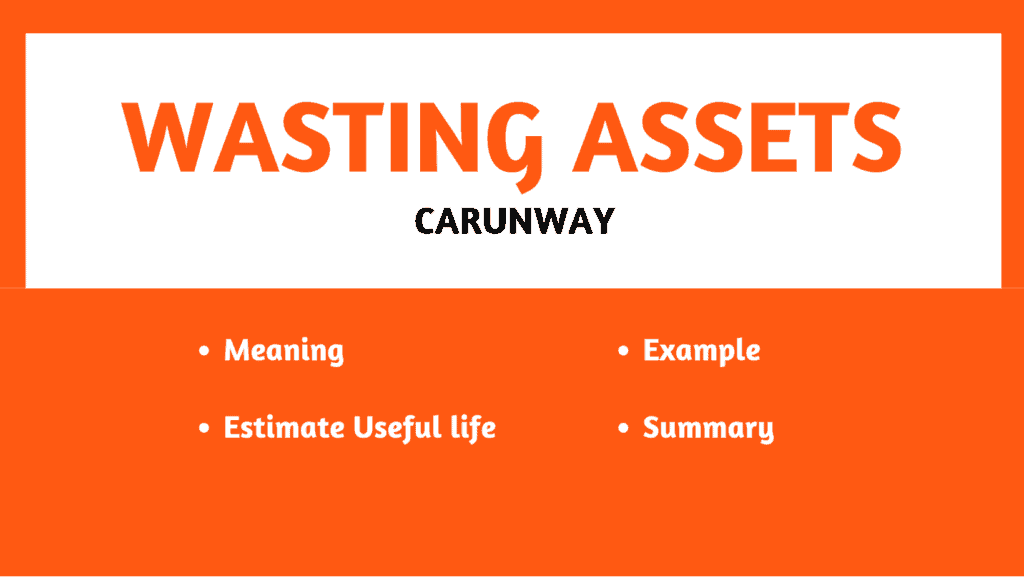Wasting assets are a type of asset or resource that, when used, is gradually consumed and eventually results in its complete depletion.
That’s quite common, right?
No Exceptions to this point.
All assets will lose its value for continued usage.
The best example is Smartphone. Irrespective of the price or the brand value, any phone will need a replacement on some day or other.
Wasting asset is typically used within an industry or business to generate revenue from the sale or consumption of the asset, but has a finite lifespan.

Table of contents
How about an example here?
- Generate Revenue from Sale – Sale of Motor Vehicles like Car, Bike, Trucks as Inventory. However, their value depreciates over time.
- Consumption of the Asset: Natural Resources like Coal reserve. Business extract Coal to produce electricity. But the Coal consumption results in reduction of reserves from the mine.
What are the most common types of wasting assets?
- Natural Resources: Natural resources such as oil, timber, and gold are considered wasting assets because their value is depleted over time
- Computer equipment, such as laptops, desktops, and servers, have a limited useful life and will eventually become outdated and lose value over time
- Vehicles are considered wasting assets because they depreciate in value over time due to wear and tear, as well as technological obsolescence. Now a days, EV Vehicles replacing the Petrol, diesel and Gas Vehicles. This is an example of technological obsolescence.
- Intangible Assets: Intangible assets, like patents or copyrights are also classified as wasting assets due to their limited value over time.
Why is it important to estimate the useful life of wasting assets?
Funds/Cash flows drive the business operations. So, the importance to estimate the useful life of wasting assets revolve around the finances. Let’s understand these in detail
- Estimating the useful life of wasting assets is important for companies to accurately plan their finances for the year.
- An accurate estimate can also help businesses avoid spending too much on an asset that is nearing the end of its useful life.
- Estimating the useful life of a wasting asset can also help prevent costly surprises due to unexpected depreciation expenses.
- Additionally, knowing the useful life of an asset can help reduce costs by making sure that businesses replace or upgrade equipment before it becomes obsolete or needs major repairs.
How to estimate the useful life of wasting assets?
1. Understand the concept of a wasting asset:
It is an item with a limited life span that irreversibly declines in value over time. Examples include depreciating fixed assets such as construction equipment.
2. Calculate the useful life of the wasting asset:
The exact useful life of the asset is important for financial planning. Consider the Industry Standards or estimates of Peer Company. If required, we can reach out to a subject matter expert and get an estimate. To do this, divide the cost of the asset by its expected life and calculate its residual value.
3. Take into account various factors:
When calculating accelerated depreciation, consider factors such as invading capital or oil-independent GDP to get an accurate estimate of the asset’s useful life.
4. Monitor the status of depreciable assets:
Use a Fixed Assets Register to keep track of assets, including when they are due for replacement or have outlived their estimated useful life.
5. Consider periodic depreciation:
For certain assets, such as automobiles, it may be more practical to depreciate them periodically instead of annually. This can help ensure that businesses are accurately accounting for their depreciable assets over time.
6. Keep records updated:
Make sure to keep records up-to-date so that depreciation/depletion expenses can be calculated accurately and in a timely manner to ensure accurate financial reporting and planning.
Runners Insight
Depletion is a kind of write off. That’s the term used for depreciation of Natural resources.
Wasting Assets Summary
In conclusion, understanding wasting assets is essential for any organization or business as it can be a major source of income or expense. It is important to recognize the different types of wasting assets and to properly identify, record, and calculate their depreciation. Furthermore, it is important to know how to properly dispose of these assets, or to understand any advantages and disadvantages of possessing them. By learning the essential components of managing wasting assets, any organization or business can maximize the value of their assets and reduce the associated expenses.